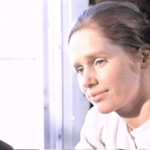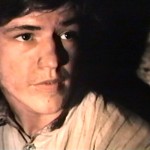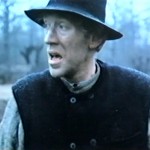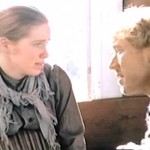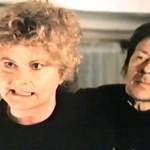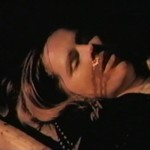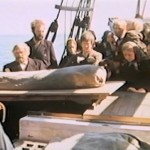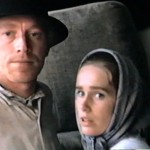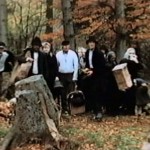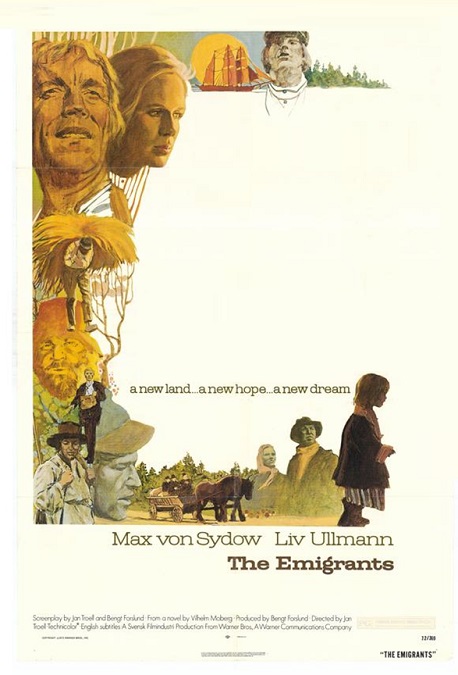
The Emigrants – 1972
Before I started watching The Emigrants, I was not aware that I already knew the story. I am familiar with one of the most gorgeous musicals it has ever been my pleasure to hear, Kristina fran Duvemala, a Swedish musical that premiered in Malmo, Sweden, in 1995. It was written by Benny Anderson and Bjorn Ulvaeus, the two men in the pop group, ABBA. The Emigrants is a film that was based on the same series of four novels by Vilhelm Moberg: The Emigrants, Unto a Good Land, The Settlers, and The Last Letter Home. The movie covers events that take place in the first two novels.
Max von Sydow and Liv Ullmann play the leads, Karl Oskar Nilsson and Kristina Nilsson, extremely poor farmers working themselves to the bone on a rocky and unproductive farm in Korpamoen, Sweden. Karl Oskar’s brother Robert, played by Eddie Axberg, is a dreamer who is physically abused by his employer when he hires himself out as a farmhand. Pierre Lindstedt plays Arvid, Robert’s best friend and fellow worker.
Poverty and no hope of a better future cause both Robert and Karl Oskar to contemplate moving to America, where the streets are supposedly paved with gold, and the land is good for farming. After the death of one of her children, Kristina agrees to go and plans are made. It isn’t long before a large party of people, including Danjel, played by Allan Edwall, and Ulrika, played by Monica Zetterlund. Danjel is fleeing from religious persecution, and Ulrika is an ex-prostitute who is one of his followers.
The second leg of the film is about the hardships the group endures while crossing the Atlantic Ocean on a 10 week voyage on a filthy boat, under horrible conditions. Then, when they finally reach America, they decide to make their way to unclaimed land in Minnesota. When the finally reach their destination, what we now know as Chisago Lake, they stake their property claims and begin to build the budding nation of America. That is where the film ends, but it is important to know that there was actually a sequel, Unto a Good Land, which brought the entire surviving cast back to reprise their roles. In it, we learn the fates of the main characters. We follow the hardships they endure, some setting down their roots and thriving in the new land, and others traveling on to new adventures.
The film has a wonderful and inspirational story and the acting was very good. Unfortunately, the film was a little hard to watch. The picture quality was horrible, the camera work was frequently shaky, the cinematography was rough, and the music was jarring and disjointed. The color quality was always washed out so badly that I might as well have been watching a film in black and white. There were times when I think the colors were supposed to be vibrant, which would have enhanced the mood and feel of scenes, but the dim and muted colors seemed to suck all the joy out of the movie.
I’m having trouble determining if it was all on purpose or not, because if it was, I don’t understand why it was nominated for Best Picture. I mean, really, it looked like it was filmed on an old Super 8, hand-held camera. Scenes which took place in bright sunlight were so overexposed that sometimes the screen actually burst into pure white. Maybe the faded colors were supposed to enhance the drab and dismal circumstances of the characters, but then I think they might have gone a little overboard.
And I mentioned the music that didn’t always seem to blend with the action taking place on the screen. Half the time it was barely noticeable, and then it would flare up to a distracting volume at unexpected times. For example, when the party of Emigrants is leaving Korpamoen for the last, the music turns into something that might have made more sense in a melodramatic horror film as the monster finally reveals itself to the screaming damsel. Music is supposed to enhance the action on the screen, not distract from it.
If it weren’t for things like this and the questionable picture quality, I think this movie had the potential to be a spectacular telling of the epic story. Instead, it just looked like a low-budget film that could have been so much more than it was. But there were 3 things that saved this film from mediocrity. The inspiring story with its wonderfully written characters that were never presented as cultural stereotypes, the capable cast of believable actors, and the down-to-earth, gritty, and realistic sets and costumes.
Though the film was made in Swedish, the only version that I could find was dubbed in English. I would have rather seen it in its original language with subtitles, but I didn’t really mind the dubbed voices. They did a good job of matching the dialogue to the lip movements of the actors. There were times when it actually looked like they were just speaking English.
